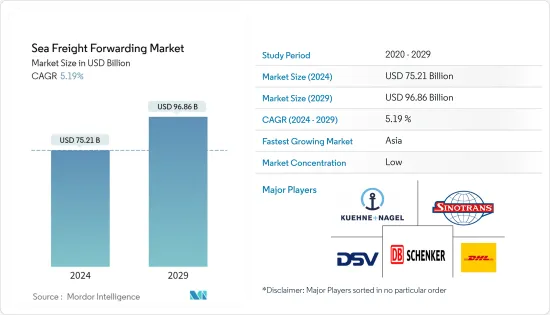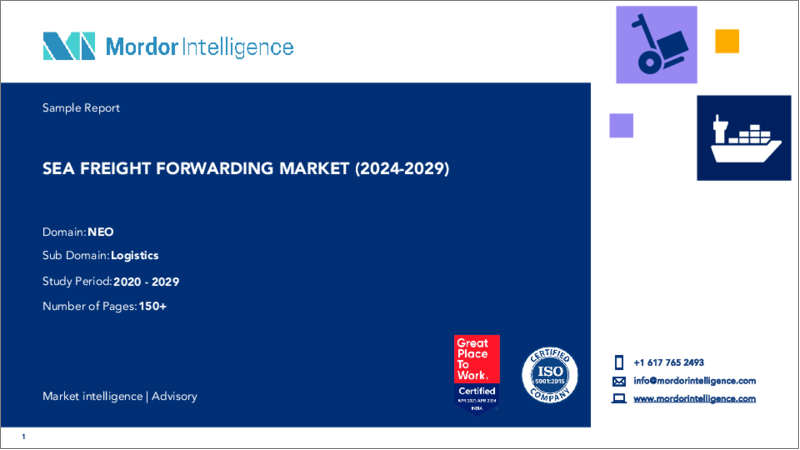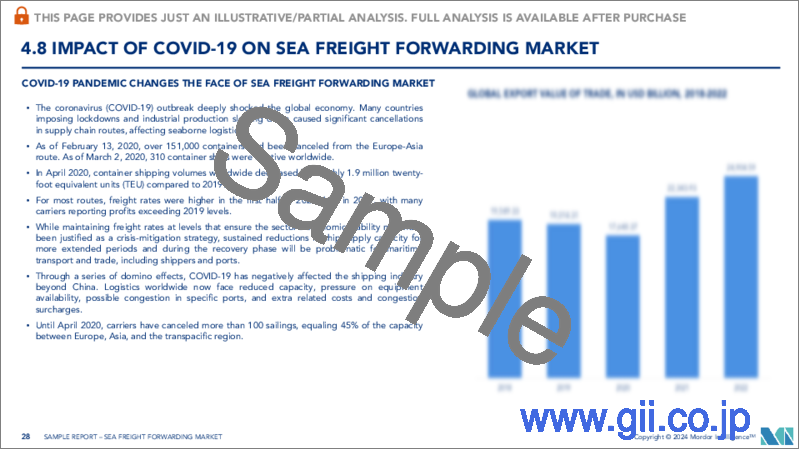|
|
市場調査レポート
商品コード
1440176
海上貨物運送:市場シェア分析、業界動向と統計、成長予測(2024-2029)Sea Freight Forwarding - Market Share Analysis, Industry Trends & Statistics, Growth Forecasts (2024 - 2029) |
||||||
カスタマイズ可能
適宜更新あり
|
|||||||
| 海上貨物運送:市場シェア分析、業界動向と統計、成長予測(2024-2029) |
|
出版日: 2024年02月15日
発行: Mordor Intelligence
ページ情報: 英文 150 Pages
納期: 2~3営業日
|
全表示
- 概要
- 目次
海上貨物運送市場規模は2024年に752億1,000万米ドルと推定され、2029年までに968億6,000万米ドルに達すると予測されており、予測期間(2024年から2029年)中に5.19%のCAGRで成長します。

主なハイライト
- インターネットの普及拡大、購買力平価の上昇、特にeコマース業界向けに設計されたインフラストラクチャとサービスの発展により、世界の海上貨物運送市場は活況を呈しています。新型コロナウイルス感染症の感染拡大は、安全とCOVID-19の拡大防止のため、海運業界の従業員が閉鎖されたため、海運業界に悪影響を及ぼしました。
- 海上貨物運送は、いくつかのエンドユーザー業界の間で好ましいモードとして浮上しており、いくつかの戦略的パートナーシップも予測期間中に海上貨物運送の成長を促進する可能性があります。成長する世界の国境を越えたeコマース市場はLCLの量を押し上げており、海上貨物運送市場の成長にプラスの影響を与えています。
- 海上輸送は、何千年もの間、物品、製品、人々を輸送する重要な手段でした。今日、船舶は石炭、石油・ガスの重要な商品を輸送し、世界経済を支えています。 2021年だけでも、石炭約150万トン、石油約110万トンが出荷されました。
- さらに重要なことは、全物品の約85%が主にコンテナ船などの海上輸送であることです。他の輸送手段と比較して、船舶は、排出量が比較的少量でありながら、より経済的で、大きく、重く、かさばる品目の輸送に適した膨大な容量を備えています。
- 船主やアナリストによると、今年の残りの期間と2023年にかけて、海運料金はさらに低下すると予想されています。今後2年間で多数の新造船が就航するため、船隊規模の純成長率は2023年から2024年にかけて9%以上になると予想されます。対照的に、ブレーマー氏によると、2024年のコンテナ量の伸びはわずかにマイナスになる可能性があります。
海上貨物運送市場動向
台頭するクロスブローダーeコマースが市場を牽引
2021年の世界の小売eコマース売上高は約5兆2,110億米ドルに達し、電子小売収益は今後数年間でより速いペースでさらに成長すると予測されています。さらに、オンラインショッピングは世界中で最も人気のあるオンライン活動の1つであるため、国内および中国、インド、インドネシアなどの新興国市場における国境を越えたeコマースの両方を推進しています。これには、消費者直販だけでなく、電子機器、医薬品、消費者向けパッケージ商品の出荷も含まれます。
新興経済諸国製造による成長から中間層の拡大によるより高い消費レベルへ徐々に移行していく中で、eコマースの成長はこの地域の消費の伸びと非常に密接に結びついています。
中国ではすでに、国境を越えたeコマースが輸出入総取引量の最大25%を占めています。中国と比較すると、他の地域のeコマース関連ビジネスの規模は、はるかに小さいですが、その成長も急速です。eコマースの貨物輸送で最も好まれる手段の1つは海上輸送であり、海上輸送量が2021年に200億トンに増加することからもわかるように、多くの企業が海上輸送を支持しています。
海上貿易輸送量の増加
海上貿易の成長は、輸送コストの削減により世界中の顧客に利益をもたらします。輸送手段としての海運効率の向上とさらなる経済自由化により、業界の継続的な成長の見通しは引き続き良好です。
現在の状況にもかかわらず、業界の長期的な見通しは依然として非常に良好です。世界の人口は依然として増加しており、発展途上国は海運が安全かつ効果的に輸送するより多くの商品や原材料を今後も必要とするでしょう。最近、海上で行われる国際貿易の量が再び着実に増加し始めています。海運が最も環境に優しく、費用対効果の高い商業輸送手段であるという事実は、最終的には世界貿易に占める海上輸送の割合の増加につながるはずです。
50,000隻を超える商船が海外で運航し、あらゆる種類の商品を輸送しています。ほぼあらゆる国籍の100万人以上の船員が世界の船団を構成しており、150か国以上に登録されています。
国連貿易開発会議(UNCTAD)によると、商船の運航は世界経済に約3,800億米ドル相当の運賃を生み出しており、これは全貿易の約5%に相当します。
自由貿易と消費財の需要の拡大は、工業化の進展と国民経済の自由化によって促進されてきました。技術の進歩により、輸送手段としての輸送の効率と速度も向上しました。
1990年から2020年の間に、海上貿易量は2倍以上に増加し、106億5,000万トンに達しました。 2020年には、18億5,000万トンの国際海上貿易がコンテナ船によって運ばれました。 2021年1月の時点で、パナマは3億4,360万DWTのオペレーター席を備えた世界最大の商船隊を保有していました。過去30年間で海上貿易輸送量は約3倍に増加し、2021年には1,500億トンに達したため、海上貨物運送業者の業務量は着実に増加しています。
海上貨物運送業界の概要
海上貨物運送市場は競争が激しく、多くのプレーヤーが存在するため非常に細分化されています。海上貨物運送業者は、仲介者として機能し、一般の海上運送業者を通じて荷物を発送し、顧客に代わって荷物のすべての手配を行う個人または会社です。
海上貨物運送業者は、必要な物流をすべて処理し、出荷に関連する活動を実行します。海上貨物量は2012年から2022年にかけて3倍に増加しており、ここ数年で市場には多くの新規参入者が現れています。
市場における既存の主要企業には、Kuehne+Nagel、DHL Supply Chain &Global Forwarding、DB Schenker、DSV Panalpina、Sinotrans、Expeditors、日本通運、CEVA Logistics、CH Robinson、Kerry Logisticsなどがあります。
その他の特典
- エクセル形式の市場予測(ME)シート
- 3か月のアナリストサポート
目次
第1章 イントロダクション
- 調査の成果
- 調査の前提条件
- 調査範囲
第2章 調査手法
- 分析調査手法
- 調査段階
第3章 エグゼクティブサマリー
第4章 市場洞察
- 現在の市場シナリオ
- バリューチェーン/サプライチェーン分析
- 技術動向
- 投資シナリオ
- 政府の規制と取り組み
- スポットライト-海上輸送コスト/運賃
- eコマース業界に関する洞察
- COVID-19症による海上貨物運送市場への影響
第5章 市場力学
- 市場促進要因
- 市場抑制要因
- 市場機会
- 業界の魅力- ポーターのファイブフォース分析
- 供給企業の交渉力
- 消費者の交渉力
- 新規参入業者の脅威
- 代替品の脅威
- 競争企業間の敵対関係の激しさ
第6章 市場セグメンテーション
- タイプ別
- FCL
- LCL
- その他
- 地域別
- 北米
- 米国
- カナダ
- メキシコ
- 欧州
- ドイツ
- フランス
- オランダ
- 英国
- イタリア
- その他欧州
- アジア太平洋
- 中国
- 日本
- オーストラリア
- インド
- シンガポール
- マレーシア
- インドネシア
- 韓国
- その他アジア太平洋地域
- 中東とアフリカ
- 南アフリカ
- エジプト
- GCC諸国
- その他中東とアフリカ
- 南米
- ブラジル
- チリ
- その他南米
- 北米
第7章 競合情勢
- 市場集中の概要
- 企業プロファイル
- Kuehne+Nagel
- Sinotrans
- DHL
- DB Schenker
- DSV Panalpina
- Expeditors
- CH Robinson
- Ceva Logistics
- Kerry Logistics
- Nippon Express
- Hellmann Worldwide Logistics
- Geodis
- Fr. Meyer's Sohn
- Yusen Logistics
- Bollore Logistics
第8章 市場の将来
第9章 免責事項
The Sea Freight Forwarding Market size is estimated at USD 75.21 billion in 2024, and is expected to reach USD 96.86 billion by 2029, growing at a CAGR of 5.19% during the forecast period (2024-2029).

Key Highlights
- The global sea freight forwarding market is booming, owing to the growing internet penetration, increasing Purchasing Power Parity, and developments in infrastructure and services designed particularly for the e-commerce industry. The epidemic negatively impacted the shipping industry as workforces in these sectors were shut down for safety and to prevent the spread of COVID-19.
- Sea freight forwarding has emerged as a preferred mode among several end-user industries and several strategic partnerships are also likely to promote the growth of sea freight forwarding during the forecast period. The growing global cross-border e-commerce market is driving the LCL volume and is positively impacting the sea freight forwarding market growth.
- Sea freight has been an important means of transporting goods, products, and people for thousands of years. Today, ships transport vital commodities such as coal, oil and gas, supporting the global economy. In 2021 alone, about 1.5 million tonnes of coal and about 1.10 million tonnes of oil were shipped.
- More importantly, about 85% of all goods are transported by sea, mainly by container ships. Compared to other means of transport, vessels have vast capacities suitable for transporting large, heavy, and bulky items that are more economical while producing relatively small amounts of emissions.
- Shipping rates are expected to drop further for the rest of the year and into 2023, according to shipowners and analysts. With a number of new vessels entering service over the next two years, net growth in the fleet size is expected to be over 9% through 2023 to 2024. By contrast, container volume growth in 2024 could be slightly negative according to Braemer.
Sea Freight Forwarding Market Trends
Rising Cross Broder E-Commerce is driving the Market
In 2021, retail e-commerce sales worldwide amounted to around USD 5,211 Billion and e-retail revenues are projected to grow even further at a quicker pace in the coming few years. Further, as online shopping is one of the most popular online activities worldwide is driving both the domestic and cross-border e-commerce in developing markets such as China, India, and Indonesia. This encompasses not just direct-to-consumer retail, but also shipments of electronics, pharmaceuticals, and consumer packaged goods.
Growth in e-commerce is tied very closely to the consumption growth in the region as developing economies make the gradual shift from growth by manufacturing for export to higher levels of consumption by expanding middle classes.
In China, cross-border e-commerce transactions already accounted for up to 25 percent of total import and export trading volumes. Compared to China, in other regions, the size of e-commerce related businessess is much smaller, but the growth is also rapid. One of the most preferred modese for e-commerce freight forwarding is through sea and many business are favoring that as evidenced by the growing of ocean freight volumes to 20 billion tons in 2021.
Rise In Seaborne Trade Transport Volume
The growth of seaborne trade benefits customers all around the world by lowering the cost of shipping. The prospects for the industry's continued growth remain favorable due to the increasing efficiency of shipping as a mode of transportation and further economic liberalization.
Despite the current circumstances, the industry's long-term prospects are still highly favorable. The world's population is still growing, and developing nations will keep needing more of the goods and raw materials that shipping transfers so securely and effectively. The volume of international trade conducted by sea has recently started to rise steadily once more. The fact that shipping is the most environmentally benign and cost-effective method of commercial transportation should eventually lead to an increase in the percentage of world trade that is transported by sea.
Over 50,000 merchant ships operate abroad and carry all different kinds of goods. More than a million seafarers of essentially every nationality make up the world fleet, which is registered in more than 150 countries.
According to the United Nations Conference on Trade and Development (UNCTAD), the operation of commercial ships generates freight rates worth roughly USD 380 billion for the global economy or about 5% of all trade.
The expansion of free trade and the demand for consumer goods has been fueled by rising industrialization and the liberalization of national economies. Technology advancements have also increased the effectiveness and speed of the shipping as a mode of transportation.
Between 1990 and 2020, seaborne trade volumes more than doubled to reach 10.65 billion tons. In 2020, 1.85 billion tons of international seaborne trade was carried by container ships. As of January 2021, Panama had the world's largest merchant fleet with 343.6 million DWT operator seats. The business volume of ocean freight forwarders has been steadily increasing because in the last three decades, the seaborne trade transport volume roughly tripled, reaching 150 billion metric tons in 2021.
Sea Freight Forwarding Industry Overview
The Sea Freight Forwarding Market is highly competitive and is highly fragmented with the presence of many players. A Sea Freight forwarder is an individual or company that acts as an intermediary and dispatches the shipments via common sea carriers and makes all arrangements for those shipments on behalf of its clients.
Sea Freight forwarders handle all the logistics needed and perform activities pertaining to shipments. With the Ocean freight volumes tripling from 2012 to 2022, the market has seen many new players entering in the last few years.
Some of the existing major players in the market include Kuehne + Nagel, DHL Supply Chain & Global Forwarding, DB Schenker, DSV Panalpina, Sinotrans, Expeditors, Nippon Express, CEVA Logistics, C.H. Robinson, and Kerry Logistics.
Additional Benefits:
- The market estimate (ME) sheet in Excel format
- 3 months of analyst support
TABLE OF CONTENTS
1 INTRODUCTION
- 1.1 Study Deliverables
- 1.2 Study Assumptions
- 1.3 Scope of the Study
2 RESEARCH METHODOLOGY
- 2.1 Analysis Methodology
- 2.2 Research Phases
3 EXECUTIVE SUMMARY
4 MARKET INSIGHTS
- 4.1 Current Market Scenario
- 4.2 Value Chain / Supply Chain Analysis
- 4.3 Technological Trends
- 4.4 Investment Scenarios
- 4.5 Government Regulations and Initiatives
- 4.6 Spotlight - Sea Freight Transportation Costs/Freight Rates
- 4.7 Insights on the E-commerce Industry
- 4.8 Impact of COVID-19 on the Sea Freight Forwarding Market
5 MARKET DYNAMICS
- 5.1 Market Drivers
- 5.2 Market Restraints
- 5.3 Market Opportunities
- 5.4 Industry Attractiveness - Porter's Five Forces Analysis
- 5.4.1 Bargaining Power of Suppliers
- 5.4.2 Bargaining Power of Consumers
- 5.4.3 Threat of New Entrants
- 5.4.4 Threat of Substitutes
- 5.4.5 Intensity of Competitive Rivalry
6 MARKET SEGMENTATION
- 6.1 By Type
- 6.1.1 Full Container Load (FCL)
- 6.1.2 Less-than Container Load (LCL)
- 6.1.3 Others
- 6.2 By Geography
- 6.2.1 North America
- 6.2.1.1 United States
- 6.2.1.2 Canada
- 6.2.1.3 Mexico
- 6.2.2 Europe
- 6.2.2.1 Germany
- 6.2.2.2 France
- 6.2.2.3 Netherlands
- 6.2.2.4 United Kingdom
- 6.2.2.5 Italy
- 6.2.2.6 Rest of Europe
- 6.2.3 Asia-Pacific
- 6.2.3.1 China
- 6.2.3.2 Japan
- 6.2.3.3 Australia
- 6.2.3.4 India
- 6.2.3.5 Singapore
- 6.2.3.6 Malaysia
- 6.2.3.7 Indonesia
- 6.2.3.8 South Korea
- 6.2.3.9 Rest of Asia-Pacific
- 6.2.4 Middle East & Africa
- 6.2.4.1 South Africa
- 6.2.4.2 Egypt
- 6.2.4.3 GCC Countries
- 6.2.4.4 Rest of Middle East & Africa
- 6.2.5 South America
- 6.2.5.1 Brazil
- 6.2.5.2 Chile
- 6.2.5.3 Rest of South America
- 6.2.1 North America
7 COMPETITIVE LANDSCAPE
- 7.1 Market Concentration Overview
- 7.2 Company Profiles
- 7.2.1 Kuehne + Nagel
- 7.2.2 Sinotrans
- 7.2.3 DHL
- 7.2.4 DB Schenker
- 7.2.5 DSV Panalpina
- 7.2.6 Expeditors
- 7.2.7 C.H Robinson
- 7.2.8 Ceva Logistics
- 7.2.9 Kerry Logistics
- 7.2.10 Nippon Express
- 7.2.11 Hellmann Worldwide Logistics
- 7.2.12 Geodis
- 7.2.13 Fr. Meyer's Sohn
- 7.2.14 Yusen Logistics
- 7.2.15 Bollore Logistics





